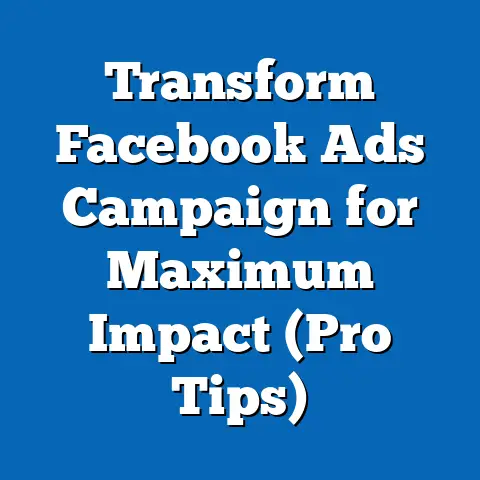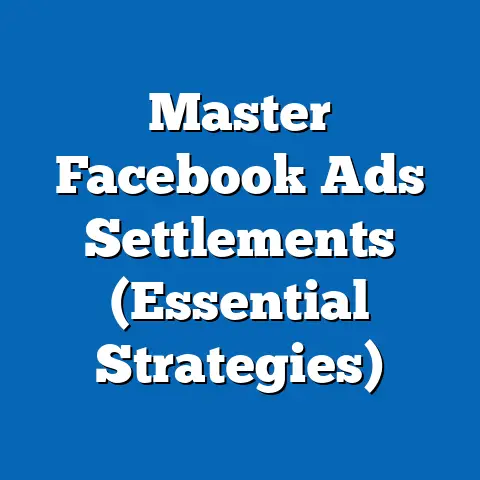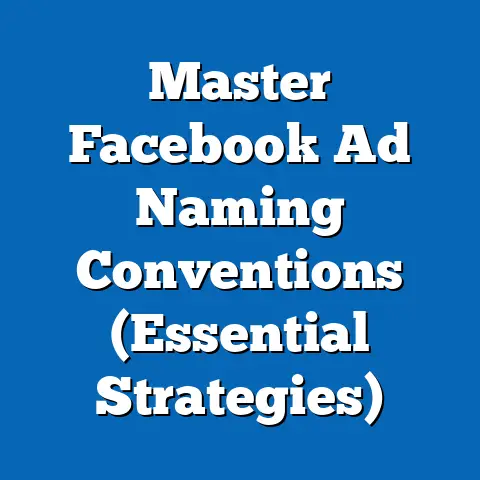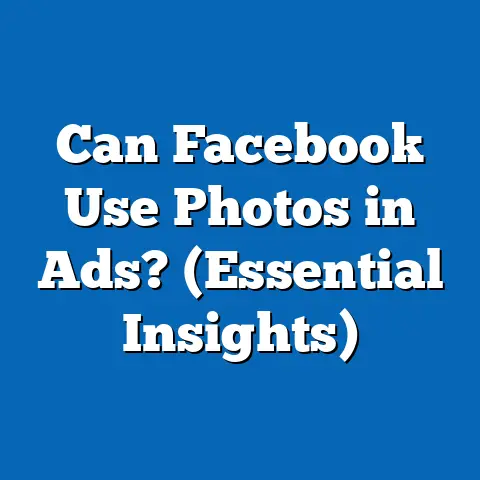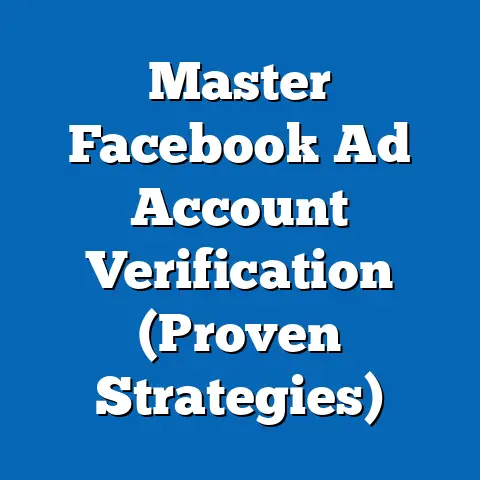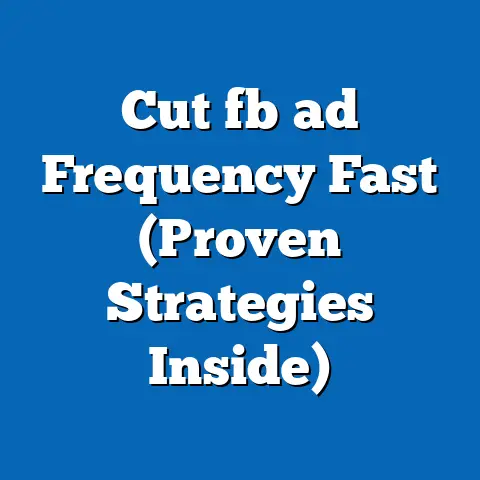Maximize ROI with Facebook Audience Types (Strategic Insights)
In today’s fast-paced digital marketing landscape, where every penny counts, simply throwing ads out into the digital void is no longer a viable strategy. I’ve seen firsthand how crucial targeted advertising has become, especially on platforms like Facebook, where users are bombarded with content from every direction. The key to cutting through the noise lies in understanding and leveraging the power of audience segmentation.
Return on Investment (ROI) is the holy grail of advertising. It’s the metric that tells us if our efforts are actually paying off. Without a solid ROI, we’re essentially pouring money down the drain. Recent trends in social media advertising have shown a clear shift towards more sophisticated audience targeting techniques. We’re no longer just targeting “women aged 25-34 interested in fashion.” We’re diving deep into their behaviors, interests, and even their past interactions with our brand. This article will serve as your guide to navigating the intricate world of Facebook audience types, providing strategic insights to maximize your ROI and ensure your advertising dollars are working as hard as possible. I’ll walk you through the ins and outs of Core Audiences, Custom Audiences, and Lookalike Audiences, showing you how to leverage each one for optimal results.
Understanding Facebook Audience Types
Facebook offers a trifecta of audience targeting options, each designed to reach different segments of your potential customer base. These are:
- Core Audiences: These are built using Facebook’s vast database of user information, allowing you to target people based on demographics, interests, behaviors, and location.
- Custom Audiences: This allows you to upload your own data, such as customer lists, website visitor information, or app user data, to create highly targeted audiences.
- Lookalike Audiences: These are created by Facebook based on your existing Custom Audiences, identifying new potential customers who share similar characteristics with your best customers.
Each audience type offers unique advantages and is suited for different stages of the customer journey. Understanding the nuances of each is essential for crafting effective ad campaigns and achieving a strong ROI.
Understanding audience preferences, behaviors, and demographics is paramount. It’s like having a cheat sheet to your customer’s mind. Knowing what they like, what they do, and where they are allows you to tailor your message to resonate with them on a personal level. This personalized approach leads to higher engagement, better conversion rates, and ultimately, a greater ROI.
Statistics consistently demonstrate the effectiveness of targeted advertising on Facebook. Studies have shown that targeted ads can increase click-through rates (CTR) by as much as 2x and conversion rates by up to 3x compared to non-targeted ads. This highlights the power of reaching the right people with the right message at the right time.
Key Takeaway: Facebook offers three main audience types: Core, Custom, and Lookalike. Understanding their unique characteristics is crucial for effective targeting and maximizing ROI.
Core Audiences – Targeting the Right Demographics
Core Audiences are the foundation of Facebook advertising. They allow you to tap into Facebook’s massive database of user information to target potential customers based on a wide range of criteria:
- Demographics: Age, gender, education level, job title, relationship status, and more.
- Interests: Hobbies, passions, activities, and topics that users have expressed interest in on Facebook.
- Behaviors: Purchase behaviors, device usage, travel habits, and other actions users have taken on and off Facebook.
- Location: Country, region, city, or even specific zip codes.
The power of Core Audiences lies in their flexibility and granularity. You can combine these criteria to create highly specific target audiences that align perfectly with your ideal customer profile.
Audience segmentation is the key to unlocking the full potential of Core Audiences. Instead of targeting a broad audience with a generic message, you can segment your audience into smaller, more defined groups based on their characteristics and tailor your ads accordingly. For example, a clothing retailer might segment their audience into “college students interested in streetwear” and “young professionals interested in business casual.”
Understanding current trends in audience behavior on Facebook is crucial for informing your targeting strategies. For instance, if you know that a particular demographic is increasingly engaging with video content, you can prioritize video ads when targeting that audience. I regularly check Facebook’s own resources and industry reports to stay on top of these trends.
Here’s an example of a successful campaign that effectively used Core Audiences: A local gym targeted “men aged 25-45 in [city name] interested in fitness and weightlifting” with ads promoting a special offer on their personal training packages. By focusing on a specific demographic with a clear interest in their services, they were able to achieve a high conversion rate and a strong ROI.
Key Takeaway: Core Audiences allow you to target potential customers based on demographics, interests, behaviors, and location. Audience segmentation and staying up-to-date on audience behavior trends are essential for maximizing ROI.
Custom Audiences – Re-engaging Past Customers
Custom Audiences take targeting to a whole new level by allowing you to leverage your own data. You can create Custom Audiences from:
- Customer Lists: Upload a list of your existing customers (email addresses, phone numbers, etc.) to target them with specific offers or messages.
- Website Visitors: Retarget people who have visited your website with relevant ads.
- App Users: Target people who have downloaded or used your mobile app.
The power of Custom Audiences lies in their ability to re-engage past customers and nurture them further down the sales funnel. These are people who already know your brand and have shown some level of interest in your products or services.
Re-engagement strategies are crucial for maximizing the lifetime value of your customers. By targeting past customers with relevant offers and reminders, you can keep them engaged with your brand and encourage them to make repeat purchases. I’ve seen companies significantly increase their revenue by simply focusing on re-engaging their existing customer base.
Retargeting campaigns are particularly effective when using Custom Audiences. For example, if someone visited a specific product page on your website but didn’t make a purchase, you can retarget them with an ad showcasing that product and offering a discount.
Here’s a real-life example of a brand that successfully utilized Custom Audiences: An e-commerce store uploaded their customer email list to create a Custom Audience and targeted them with an exclusive discount code. This resulted in a significant increase in sales and a strong ROI.
Key Takeaway: Custom Audiences allow you to target your existing customers, website visitors, and app users. Re-engagement strategies and retargeting campaigns are highly effective when using Custom Audiences.
Lookalike Audiences – Expanding Reach
Lookalike Audiences are a powerful tool for expanding your reach and finding new potential customers who share similar characteristics with your best existing customers. Facebook uses its sophisticated algorithms to analyze your Custom Audiences and identify users who are likely to be interested in your products or services.
You can create Lookalike Audiences based on:
- Customer Lists: Find new customers who are similar to your best existing customers.
- Website Visitors: Reach people who are similar to those who have visited your website.
- App Users: Target people who are similar to those who have downloaded or used your app.
The benefits of using Lookalike Audiences are numerous:
- Increased Reach: Expand your reach beyond your existing customer base.
- Improved Targeting: Reach people who are more likely to be interested in your products or services.
- Higher Conversion Rates: Attract new customers who are similar to your best existing customers.
Strategic use of Lookalike Audiences is essential for scaling ad campaigns while maintaining a high ROI. Start by creating Lookalike Audiences based on your most valuable Custom Audiences, such as your top-spending customers or your most engaged website visitors.
Key Takeaway: Lookalike Audiences allow you to find new potential customers who share similar characteristics with your best existing customers. Strategic use of Lookalike Audiences is essential for scaling ad campaigns and maintaining a high ROI.
Analyzing Performance and Adjusting Strategies
Creating the perfect audience is only half the battle. The real magic happens when you continuously monitor and analyze your ad performance and adjust your strategies accordingly.
Key Performance Indicators (KPIs) that you should track to assess ROI and audience effectiveness include:
- Click-Through Rate (CTR): The percentage of people who see your ad and click on it.
- Conversion Rate: The percentage of people who click on your ad and complete a desired action (e.g., make a purchase, fill out a form).
- Cost Per Acquisition (CPA): The cost of acquiring a new customer.
- Return on Ad Spend (ROAS): The revenue generated for every dollar spent on advertising.
Facebook Ads Manager provides a wealth of tools and analytics to help you understand audience engagement and optimize your campaigns. Pay close attention to the demographics, interests, and behaviors of the people who are engaging with your ads. This will give you valuable insights into what’s working and what’s not.
Data-driven decisions are the key to improving your ROI. If you see that a particular audience segment is not performing well, don’t be afraid to adjust your targeting or try a different ad creative. I’ve often had to completely overhaul my targeting strategy based on the data I’ve collected.
Here’s an example of how data-driven decisions can lead to improved outcomes: A restaurant was running ads targeting “foodies in [city name].” However, they noticed that the CTR was low. After analyzing the data, they realized that their ads were primarily being shown to people who lived far away from the restaurant. They adjusted their targeting to focus on people who lived within a 5-mile radius of the restaurant, and the CTR significantly increased.
Key Takeaway: Continuous monitoring and analysis of ad performance are essential for optimizing your campaigns and maximizing ROI. Use Facebook Ads Manager to track key performance indicators and make data-driven decisions.
Conclusion
Leveraging the power of Facebook audience types is crucial for maximizing ROI in today’s competitive advertising landscape. By understanding the nuances of Core Audiences, Custom Audiences, and Lookalike Audiences, you can craft highly targeted ad campaigns that resonate with your ideal customers and drive better results.
The world of Facebook advertising is constantly evolving, so it’s essential to stay updated on the latest trends and audience insights. Don’t be afraid to experiment with different targeting strategies and ad creatives to see what works best for your business.
I encourage you to take a strategic approach to audience targeting, using the insights shared in this article to enhance your advertising efforts and drive better results. Remember, the key to success on Facebook is to reach the right people with the right message at the right time. By focusing on audience segmentation and data-driven decision-making, you can unlock the full potential of Facebook advertising and achieve a strong ROI. Now go out there and start building those high-performing audiences!

